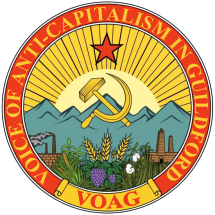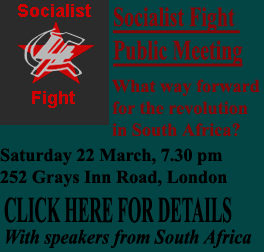 The debate on the causes of the Great Recession
The debate on the causes of the Great Recession
Mick Brooks, Author of Capitalist Crisis: Theory and Practice, comments here on the debate within the Committee For a Workers’ International on The Causes of the Great Recession and Capitalist Crisis.
Mick Brooks, September 2013
Since the outbreak of the Great Recession Marxists have debated its cause. This is a vital theoretical issue for understanding the world around us.
The debate centres around the issue as to whether the present crisis is caused by falling profits as explained by Marx’s law of the tendential fall in the rate of profit (LTFRP), dealt with in chapters 13-15 of ‘Capital Volume III’. Others argue that the crisis can be explained as one of underconsumption.
This debate is bubbling under within the ranks of the CWI. The leadership of the CWI (as of the IMT) take what I would characterise as an underconsumptionist position. Already two blogs are circulating inside the ranks of the CWI that advocate the LTFRP explanation, in addition to an excellent short film, and debates are beginning to take place in the localities. Signs of intelligent life? It looks like it. Check out:
Marx returns from the Grave, http://69.195.124.91/~brucieba/
Socialism is Crucial, http://socialismiscrucial.wordpress.com/
It should be explained at the outset that all parties agree that a crisis of capitalism takes theform of overproduction, of unsold goods, as it says in the ‘Communist Manifesto’. Overproduction and crisis, however, are not permanent features of capitalist production. It remains to be explained why capitalism dips into crisis when it does.
The leadership, reacting to criticism, has resorted to an ‘underconsumptionist’ explanation of the cause of crisis. The crisis is caused, according to a quote from Chapter 30 of ‘Capital Volume III’ by “the poverty and restricted consumption of the masses.” (As one of the bloggers, CrucialSteve, points out this was actually a bracketed note added by Engels into the original text.)
The problem with the underconsumptionist explanation is that there is a permanent tendency for capitalism to restrict the purchasing power of the working class, because it is a system based on profit. Underconsumptionism therefore has no explanatory power as an explanation of crisis.
In any case not all commodities are produced for workers – pallet trucks and computer numerically controlled machine tools are capital goods bought by capitalists. There are also luxury goods consumed only by capitalists such as yachts and private jets. Why should there be a specific outbreak of overproduction of consumer goods intended for workers’ consumption such as jumpers rather than pallet trucks or yachts? Empirically crises of overproduction usually break out in the capital goods industries. Investment is the most volatile element in national income.
The opposition bloggers within the CWI have a powerful argument in their favour – the rate and mass of profit in the major capitalist countries fell sharply prior to the onset of crisis in 2007. Marx’s theory is confirmed! To take the case of the USA: “The US Bureau of Economic Analysis (BEA) shows that in the 3rd quarter of 2006 the mass of profits peaked at $1,865bn. By the 4th quarter of 2008 it bottomed out at $861bn.” (Brooks – Capitalist crisis; theory and practice, p.32)
The facts confirm Marx’s analysis of the LTFRP as the fundamental cause of crisis. Why should this cause surprise, since we all agree that capitalism is a system of production of profit? The school of Marxian economists who support this analysis view the falling rate and also mass of profit only as an underlying cause of crisis. Essentially the argument is about levels of causation in the crisis. What about the financial aspect of the crisis – the housing bubble, crazy loans and collapsing banks? Of course this was all very important. These specific factors profoundly influence the depth and nature of the downturn. Every crisis is a unique event with its own characteristics. But, with or without a ‘financial crisis’ the fact that the mass of profits in the USA, the most important capitalist country, halved over two years would have provoked a big collapse of output in any case.
How does the leadership of the CWI deal with the detailed criticisms of their approach thrown up by the advocates of the importance of the LTFRP as an explanation of crisis? Lynn Walsh argues in ‘Socialism Today’ that profit and investment have become disconnected in recent decades. “Despite the staggering increase in the share of income taken by the top 1% in the US, investment declined.”(‘Socialism Today’, November 2012) So profits (with the share of the top 1% as a proxy) are supposed have soared at the expense of working people, but this has not translated into productive investment. Walsh concludes, “This factual data, in our view confirms the analysis of a crisis in capital accumulation put forward in ‘Socialism Today’ over many years” (ibid.).
If true, this is not an explanation for a pattern of booms and slumps. It presents a stagnationist perspective for the future of capitalism, a permanent slowing down of the rate of accumulation. Is the CWI serious about decades of stagnation? How do they explain the present crisis, where investment fell as a result of the fall in profits?
In fact there is a simple explanation for this alleged disjunction between profits and investment: the profit figures quoted are wrong. Michael Roberts has meticulously chronicled the rate of profit since the Second World War in his blog. Nobody has challenged his figures, which attempt to look beneath conventional statistics to work out a Marxian rate of profit.
Roberts concludes: first that there has been no return to the fabulous profits enjoyed by capitalists during the golden years of the post-War boom; and secondly that the rate of profit today in 2013 remains below that of 2007 before the onset of the great Recession. Andrew Kliman also carefully shows (in ‘The failure of capitalist production’) that the reason for lower investment in the years since 1974 is lower profits. There is just less to invest. Simples.
The CWI leadership buttress their ‘explanation’ as to why investment has been lower with recourse to the notion of financialisation. As Lynn Walsh argues in the same article, more and more funds have been gobbled up by financial shenanigans in preference to investing in industry. There is no mystery here. In so far as more “profits disappeared into the financial sector” (ibid.), that is a response to lower pickings to be made in production – because of the LTFRP itself.
Increasing exploitation of the workers over recent decades has not led to increasing rates of accumulation because of financialisation, it is asserted. This is part of the analysis of a whole school of thought, regarding itself as Marxian, which sees the current crisis as one of the neoliberal form of capitalism rather than capitalism as a whole. In fact this is the conventional wisdom of the majority of academic Marxist economists. A whole new stage of capitalism is supposed to have developed since about 1980, buttressed by the holy trinity of globalisation, neoliberalism and financialisation.
Dumenil and Levy’s book – ‘The crisis of neoliberalism’, 2011 – is an example. Phil Hearse writing in Socialist Resistance, the publishing house of the so-called Fourth international, also refers to “a neoliberal ‘regime of accumulation’”. The logic of this approach seems to be that neoliberalism should be destroyed rather the capitalist system overthrown. As we see, the CWI leadership has swallowed this analysis whole. By accepting the interpretation of this school the CWI is on a slippery slope indeed. We’re with the opposition within their ranks on this one.



 To get a sense of how radical the Bank’s new position is, consider the conventional view, which continues to be the basis of all respectable debate on public policy. People put their money in banks. Banks then lend that money out at interest – either to consumers, or to entrepreneurs willing to invest it in some profitable enterprise. True, the fractional reserve system does allow banks to lend out considerably more than they hold in reserve, and true, if savings don’t suffice, private banks can seek to borrow more from the central bank.
To get a sense of how radical the Bank’s new position is, consider the conventional view, which continues to be the basis of all respectable debate on public policy. People put their money in banks. Banks then lend that money out at interest – either to consumers, or to entrepreneurs willing to invest it in some profitable enterprise. True, the fractional reserve system does allow banks to lend out considerably more than they hold in reserve, and true, if savings don’t suffice, private banks can seek to borrow more from the central bank.




 The Tory government claimed its intention was to close 20 pits with the loss of 20,000 jobs. When the strike began, Scargill said that the government had a long-term strategy to destroy the industry by closing over 70 pits. Not only did the Government deny this but Ian McGregor, the head of the Coal Board which managed the industry, wrote to every member of the NUM claiming Scargill was deceiving them, and that there were no plans to close any more pits than had already been announced. Cabinet Papers released this year indicate that McGregor did indeed wish to close over 90 pits.
The Tory government claimed its intention was to close 20 pits with the loss of 20,000 jobs. When the strike began, Scargill said that the government had a long-term strategy to destroy the industry by closing over 70 pits. Not only did the Government deny this but Ian McGregor, the head of the Coal Board which managed the industry, wrote to every member of the NUM claiming Scargill was deceiving them, and that there were no plans to close any more pits than had already been announced. Cabinet Papers released this year indicate that McGregor did indeed wish to close over 90 pits. Support for the miners brought together disparate radical groups across Britain, involving more people in a greater intensity of activity, over a lengthier period than any other campaign in the history of the labour movement. There were many violent incidents during the strike, the worst being clashes between striking miners and police at Orgreave. Police charged crowds on horseback with their batons and several people were seriously injured. Watch this documentary which tells some of the story of “The Battle Of Orgreave”
Support for the miners brought together disparate radical groups across Britain, involving more people in a greater intensity of activity, over a lengthier period than any other campaign in the history of the labour movement. There were many violent incidents during the strike, the worst being clashes between striking miners and police at Orgreave. Police charged crowds on horseback with their batons and several people were seriously injured. Watch this documentary which tells some of the story of “The Battle Of Orgreave”








 As the Convoy made its way to the Stones the road was blocked with tonnes of gravel and it was diverted down a narrow country lane, which was also blocked. Suddenly a group of police officers came forward and started to break vehicle windows with their truncheons. Trapped, the convoy swung into a field, crashing through a hedge.
As the Convoy made its way to the Stones the road was blocked with tonnes of gravel and it was diverted down a narrow country lane, which was also blocked. Suddenly a group of police officers came forward and started to break vehicle windows with their truncheons. Trapped, the convoy swung into a field, crashing through a hedge. 
 By the end of the day over four hundred were under arrest and dispersed across police stations around the whole of the south of England. Their homes had been destroyed, impounded and in some cases torched.
By the end of the day over four hundred were under arrest and dispersed across police stations around the whole of the south of England. Their homes had been destroyed, impounded and in some cases torched. Having seen off the miners strike – the first casualties in the plan to re-order Britain according to neo-liberal economics (or as it was known locally – Thatcherism), the state turned its force on a more subtle threat. This time not people fighting for jobs and a secure place in the system but people who rejected that system outright. Although prejudice against travellers was nothing new, the traditional ‘ethnic’ travelling minority represented no significant threat to the status quo that couldn’t be dealt with by local authorities. But to many of the millions left unemployed by the Thatcher revolution, life on the road looked increasingly appealing. This was inconvenient for a state determined that conditions for the unemployed be miserable enough to spur them into any form of low-paid work.
Having seen off the miners strike – the first casualties in the plan to re-order Britain according to neo-liberal economics (or as it was known locally – Thatcherism), the state turned its force on a more subtle threat. This time not people fighting for jobs and a secure place in the system but people who rejected that system outright. Although prejudice against travellers was nothing new, the traditional ‘ethnic’ travelling minority represented no significant threat to the status quo that couldn’t be dealt with by local authorities. But to many of the millions left unemployed by the Thatcher revolution, life on the road looked increasingly appealing. This was inconvenient for a state determined that conditions for the unemployed be miserable enough to spur them into any form of low-paid work.  Over the next ten years – notably with the Public Order Act 1986 and the Criminal Justice Act 1994 the whole lifestyle was virtually outlawed. As John Major said at the Tory Party conference in 1992 to thunderous applause: “New age travellers – not in this age – not in any age”. The CJA removed the duty of councils to provide stop-over sites for travellers and regular evictions began to punctuate traveller life. But it wasn’t all one way, thousands stayed on the road and the free festival circuit was infused with fresh blood from the rave scene. Even after the massive crackdown that followed the Castlemorton free festival the convoys in many cases moved onto road protest sites.
Over the next ten years – notably with the Public Order Act 1986 and the Criminal Justice Act 1994 the whole lifestyle was virtually outlawed. As John Major said at the Tory Party conference in 1992 to thunderous applause: “New age travellers – not in this age – not in any age”. The CJA removed the duty of councils to provide stop-over sites for travellers and regular evictions began to punctuate traveller life. But it wasn’t all one way, thousands stayed on the road and the free festival circuit was infused with fresh blood from the rave scene. Even after the massive crackdown that followed the Castlemorton free festival the convoys in many cases moved onto road protest sites. 

You must be logged in to post a comment.